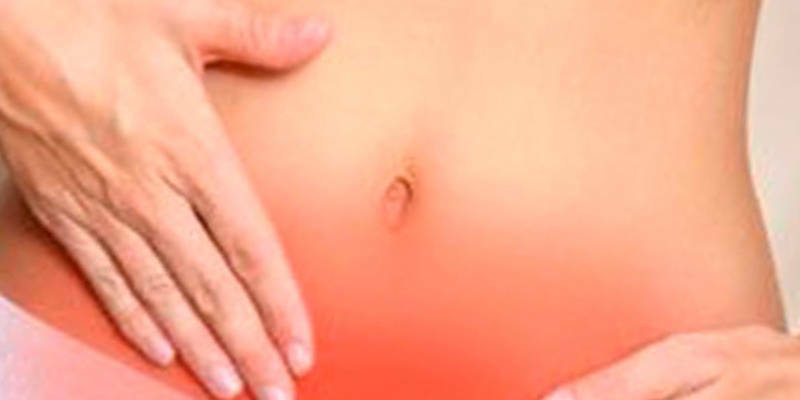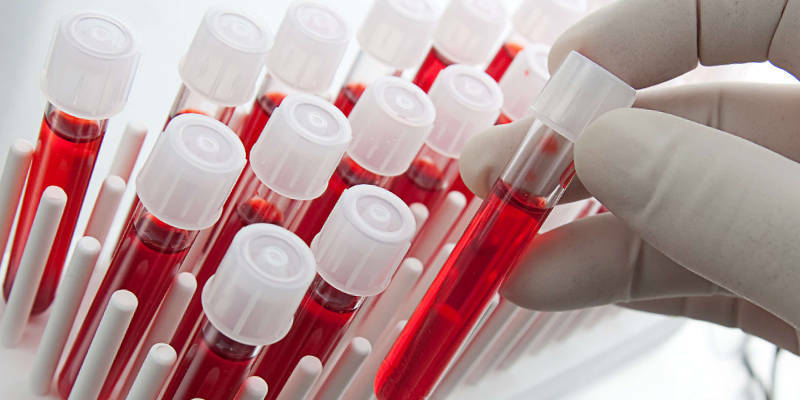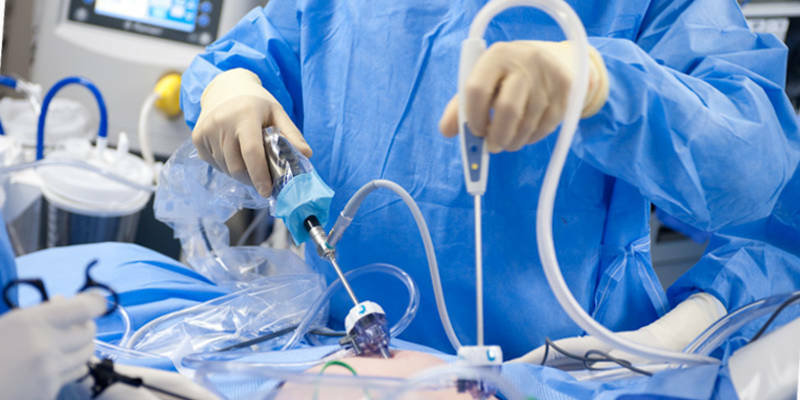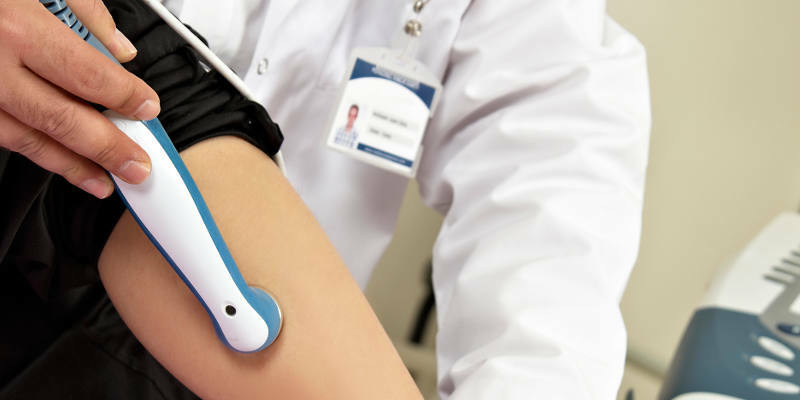
Page contents
- 1 Indications for operation
- 2 Contraindications to laparoscopy
- 3 Preparation for operation
- 4 After operation
- 5 Possible complications
- 6 Where is the operation performed?
- 7 Conclusion
Ovarian cysts almost never respond to conservative treatment. The only radical way to get rid of it is laparoscopy of the ovarian cyst. This modern and minor trauma surgery is usually carried out in a planned manner. Assigning her, the doctor will explain the features of preparation for the procedure, possible risks and rules of treatment in the postoperative period.
Indications for Operation

There are several different types of ovarian cysts. Some of them( luteal, follicular) are directly related to changes in the hormonal background of a woman.
Endometrioid cysts are derived from the inner layer of the uterus. Develop during the process of growth of endometrial cells outside its cavity and often affect ovarian tissue. These types of neoplasms can be cured or reduced with the help of medications. But if they have reached a large size or are not amenable to conservative therapy, they must be surgically removed.
Other types of cysts are dermoid and mucinous - in principle they do not lend themselves to conservative treatment, and they are recommended to be removed immediately after detection. When infertility, removal of the ovarian cyst by laparoscopy is performed irrespective of its size, after which hormonal therapy directed to the restoration of reproductive functions is prescribed.
Direct indications for the removal of cyst by laparoscopy are:
- large cyst, threatening rupture and internal bleeding;
- cyst on the foot - torsion of the tumor leads to serious complications;
- endometrioid cyst;
- cysts causing hormonal imbalance;
- high risk of malignant cysts.
Endometrioid formations are first attempted to be treated medically. If such therapy is ineffective, then this kind of cyst, like everyone else, needs to be removed.
Contraindications to laparoscopy

The method of laparoscopy is considered to be the most gentle option for surgical intervention. Nevertheless, there are a number of contraindications to the operation. These include:
- high-grade obesity( 3-4);
- purulent abdominal skin diseases, fistulas;
- severe hemostasis disorders;
- presence of adhesions in the abdominal cavity;
- acute infectious diseases( ARVI, ARI, influenza);
- malignant neoplasms affecting the genitals.
There is also no laparoscopic surgery for patients who are in a state of shock, with decompensation of chronic diseases less than six months ago who underwent myocardial infarction. In addition, laparoscopy is not performed if there is a suspicion of a cyst degeneration into a malignant tumor.
The operation is not prescribed during pregnancy, and if a woman is preparing for laparoscopy of the endometrioid ovarian cyst, then she needs to use reliable contraceptive methods. The condom is preferable, as the hormonal contraceptive intake should be agreed with the attending physician. If there is a pregnancy, the operation is postponed and carried out after the birth of the baby.
Preparing for operation

To begin with, the physician determines the presence of indications for surgery, and if he believes that laparoscopy is necessary, a number of preoperative studies are prescribed. To begin with, the patient needs to donate blood for research - general and biochemical analysis, as well as screening for hemocontact infections( that is, those that are transmitted through the blood).It is necessary to find out the general state of the woman's health and to assume how she will transfer the operation, and how recovery will go in the rehabilitation period.
In addition, it is necessary to conduct a survey of the reproductive system - to do ultrasound of the pelvic organs, to determine the hormonal status, to take a swab from the vagina for a degree of purity. This will allow the specialist to understand how disrupted the work of the female's reproductive system due to the ovarian cyst and how soon she will be able to recover from the operation.
The doctor must explain the patient the basic rules of preparation for the operation. They are as follows:
- To exclude increased gassing in the intestine, it is necessary to exclude the use of carbonated beverages, baked goods, legumes and cabbage 2 days before the operation. Also it will be necessary to refuse fatty dishes, fried and smoked products.
- Before the operation in the diet can include lean meats, cereals, pasta, potatoes, stale white bread.
- Operation is usually appointed for the morning, dinner and breakfast before it can not. Do not eat or drink directly on the day of surgery.
- For additional purification of the intestine it is recommended to make a cleansing enema. Also additionally, the intake of intestinal sorbents and preparations that reduce gas production can be prescribed.
Comments from patients suggest that the preparation for surgery is relatively easy to transfer and does not cause difficulties.
Features of laparoscopy

Laparoscopic surgery allows you to remove the cyst, maximally preserving the tissue of the ovary. She is prescribed to patients of childbearing age. After menopause, another type of surgery is used: laparotomy with complete removal of the ovary. The advantage of laparoscopy is that the time of operation and the risk of dangerous complications in the postoperative period are significantly reduced. In addition, removal of the cyst is carried out through small punctures, so the patient's recovery occurs several times faster.
Right before the operation, the patient should take a shower, shave off her pubic hair and perineum, but do not apply any skin care products. Anesthesia is usually used in general, before that the anesthesiologist consults the patient, tells her how long the operation lasts, what risks there are, how to behave correctly in the first hours after anesthesia.
The patient is placed on the operating table, the head end of which is tilted down to 30 ° C.This is necessary in order for the intestine to rise to the diaphragm and open access to the ovaries. After immersing the patient in anesthesia and processing the operating field, proceed to the operation.
Access to the ovarian cyst occurs through several punctures in the abdominal wall. One incision is made under the navel - through it enter a video camera that will transfer the image to the monitor screen. Two more incisions make from below and from the side of the first - through them the surgeon introduces the tools by which he removes the cyst.
The abdominal cavity is filled with carbon dioxide during the operation to provide the best view and space for manipulation. Before starting the operation, the doctor carefully examines the ovary and cyst, making sure that there is no need for a laparotomy.
The volume of the operation can be different - removal of the cyst exclusively( mainly in women of reproductive age), wedge resection( removal of the ovary region), and removal of the entire organ. Laparoscopy allows you to perform any of these types of surgery, but it is most convenient for cystic lesions.
The removal of the cyst takes no more than half an hour, after which the tissue of the ovary is sutured. The doctor again attentively examines the organ and the freshly stitched seams, is convinced of the absence of bleeding. After that, carbon dioxide is pumped out, tools are extracted, seams are superimposed on punctures. The exit from anesthesia after laparoscopy of the ovarian cyst is carried out immediately in the operating room.
After operation

The recovery period begins immediately after the operation is completed. After a woman withdraws from anesthesia, there is discomfort and soreness in the operated area. This is absolutely normal phenomenon, which is stopped by the use of pain medication.
In the postoperative period, the patient is prescribed antibiotics that prevent the risk of infection and unwanted complications. To avoid thrombophlebitis, some women are shown taking anticoagulants.
Bed rest is prescribed for only a few hours, and by the evening of the same day the patient can already sit on the bed, walk in the ward, go to the toilet herself. Since during the laparoscopy gas is injected into the abdominal cavity, part of it can remain inside and provoke unpleasant sensations, especially in the case of slender women. To cope with the aching in the limbs, shoulders and eliminate bloating, you must perform special exercises that promote the release of gas residues. You need to do this while lying in bed.
Within 5 hours after the intervention, it is allowed to drink water and take dietary broths. The day after the operation, you can eat a little white bread and drink a jelly. In the following days, the diet consists of easily digestible food and sparing foods that do not damage the digestive tract( viscous cereals, mashed soups, steam cutlets, bitlets, omelets).Dishes are steamed, boiled, baked or stewed. From fried, fatty, spicy dishes must be discarded. Also should be excluded sweets, coffee, black tea, chocolate, ice cream, alcohol. The food should be divided into small portions up to 6 times a day.
Pain after surgery usually occurs during the same day. If they persist for a longer time, there is a need for a thorough examination - perhaps the seams were infected. A mandatory element of the postoperative period is the treatment of joints and measurement of body temperature.
When discharging the patient, the following recommendations are given:
- to avoid high physical exertion;
- do not lift weights, do not wear bags weighing more than 3 kg;
- for a month instead of a bath to take a shower;
- to prevent thromboses wear elastic underwear;
- for 1.5 months exclude visiting a bath, sauna or beach;
- within 4 weeks to refrain from intimate life.
If the patient feels well, she is discharged on the 3rd day after the operation, the hospital is closed after 14 days. In some cases, this can happen earlier, if the patient's condition allows. For several months, there is a restriction on physical activity.
After the removal of the cyst, pregnancy may occur in the next cycle, so you should always consult a doctor about the methods of protection. If a woman dreams of becoming a mother, then conception after removal of functional cysts is possible after the first menstruation. If the endometrioid cyst was subjected to removal, then first it is necessary to undergo a course of drug treatment aimed at restoring the hormonal balance.
Possible complications of

Despite the fact that laparoscopy is considered the most sparing and safe method of surgical intervention, it is impossible to completely exclude the development of complications. Among the likely problems that a woman may encounter after removal of the cyst, the following conditions can be named:
- postoperative bleeding;
- damage to organs located next to the ovary;
- vascular damage during puncture;
- slow healing or suppuration of sutures;
- adhesions in the abdominal cavity;
- postoperative complications( thrombophlebitis, peritonitis, pneumonia, adnexitis).
If after a few days after the operation the woman has a fever, there are severe pains in the lower abdomen, weakness, nausea, dizziness, you should seek medical help as soon as possible. Usually in the postoperative period, the subfebrile temperature lasts for 2-3 days, but its rise to high values and worsening of the general condition indicates an infectious complication.
Where is the operation performed?
Removal of the ovarian cyst can be done in both public and commercial clinics. The procedure is included in the list of medical manipulations for MHI, therefore it is conducted free of charge in state gynecological hospitals.
The price of the operation in commercial hospitals can vary widely, from 15 to 50 thousand rubles. This range of prices is affected by the level of the clinic, the qualifications of surgeons, the class of equipment used, and a number of other nuances.
What happens if laparoscopy is not done?
Ovarian cysts can be asymptomatic for a long time without causing any harm to the patient. In most cases, it is discovered by accident, conducting a survey on another occasion, for example, when planning a pregnancy. If the cyst does not cause any inconvenience, then it may not be necessary to remove it.
But this is not always the case. If the patient was frightened by the cost of laparoscopy of the ovarian cyst, and she refused surgery, then the cyst started up on its own may begin to increase in size. The growing cyst gradually squeezes the tissues of the ovary, causing it to degrade. Over time, this can lead to infertility.
Another danger associated with a cyst is malignant degeneration. A large cyst can cause a malignant tumor of the ovary. In this case, resort to complete removal of the organ( or both ovaries) and revision of the abdominal cavity. The possibility of preserving the reproductive function of women is not a question, since the salvation of life becomes more important.
Conclusion

Removing the ovarian cyst is not a vital operation, but it often helps to maintain the health and reproductive function of the woman. If a cyst is found and it does not respond to conservative treatment, it is necessary to resort to surgery, because in this case it is the most reliable way to recover.
Reviews
Catherine, St. Petersburg
Valentina, Naberezhnye Chelny
Sofia, Penza



